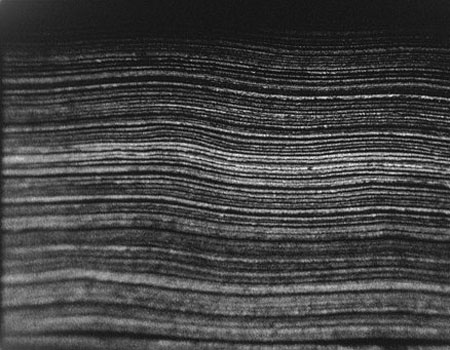Thursday, March 5, 2009, 6pm | David Gatten in person!
“Influenced equally by Stan Brakhage and Ludwig Wittgenstein.”—Ed Halter, Village Voice
For more than ten years, filmmaker and SAIC alum David Gatten’s serenely beautiful handmade films have employed experimental techniques—cellophane tape ink transfers and optical printing—to explore the relationships between text and image. Gatten transforms type into sensual topographies of time and place. The bulk of his work has centered around the books, journals, and letters of the William Byrd II family of 18th century Virginia to express the family’s ideas, secret passions, and public lives in poetic and expansive ways. This evening, Gatten will screen three of these films, including Secret History of the Dividing Line (2002), The Great Art of Knowing (2004), and How to Conduct a Love Affair (2007), along with the instructional Advanced Typing Tips Part 5 (anonymous, circa 1940) and sublime Film For Invisible Ink, Case No. 142: Abbreviation for Dead Winter [Diminished by 1, 794] (2008). Co-presented by the University of Chicago Arts Council, which will present a second program of Gatten films on Friday, March 6 at the University of Chicago’s Film Studies Center. 1940–2008, Multiple artists, USA, 16mm, ca 85 min.
——
Secret History of the Dividing Line
US, 2002, 16mm, b/w, silent, 20 min.
Paired texts as dueling histories; a journey imagined and remembered; 57 mileage markers produce an equal number of prospects. The first part of the Byrd cycle, the film focus on two texts by William Byrd, one published and official, the other secret and circulated privately. A torn timeline tells the history of the world and magnified, misaligned cement splices stand in for early 18th century landscapes. (DG)
The Great Art of Knowing
US, 2004, 16mm, b/w, silent, 37 min.
The fourth 16mm film in the Byrd project series. Taking as a point of departure the volume of the same title by the 17th century Jesuit priest Athanasius Kircher, this films attempts a peripatetic exploration of empiricism over the last 500 years. Additional material is drawn from Byrd’s papers, Leonardo da Vinci’s Codex on the Flight of Birds, as well as writings by David Hume and Jules-Etienne Marey. (DG)
How to Conduct A Love Affair
US, 2007, 16mm, color, silent, 8 min.
An unexpected letter leads to an unanticipated encounter. Some windows open easily; other shadows remain locked rooms. Advice is sometimes easy to give, but often hard to follow. Have a cup of tea dear: I’ll trade you a stitch from the past in return for a leaf from the future. At once a Valentine for a friend and a section from the next installment of the Byrd project, this film is composed of words from a 1924 instructional text, close-ups of dried tea bags sewn together into a quilt and found objects that reflect light from the past and cast shadows on the future. (DG)
Advanced Typing Tips Part 5
US, Anonymous, circa 1940, color, sound, 5 min.
An instructional film.
Film for Invisible Ink, Case no. 142: Abbreviation For Dead Winter [diminished by 1,794]
US, 2008, 16mm, b/w, silent sound, 13 min.
The second film in the Invisible Ink series is generated from single sheet of paper, with ink-and-cellophane tape transfers and microphotography of paper fibers. A long-distance dedication for a far-away friend half-way up the mountain, with words by Charles Darwin. (DG)
——
David Gatten—filmmaker, Henry James fan, recent Guggenheim fellow, and aspiring audio book producer—makes bookish films about letters and libraries and lovers and ghosts that are filled with words, some of which you can read. His work has shown around the popular planet Earth in museums, festivals, biennials, galleries, archives, access centers, elementary schools, storefronts, on sides of buildings and once on a barge that was floating down river. You can find his films in the permanent collections of the Whitney Museum of American Art and the Art Institute of Chicago but only rarely can he find his glasses. He lives and works by the water in Red Hook, Brooklyn and on Seabrook Island, South Carolina and teaches 16mm filmmaking/Wallace Stevens appreciation at The Cooper Union in New York City.
More
